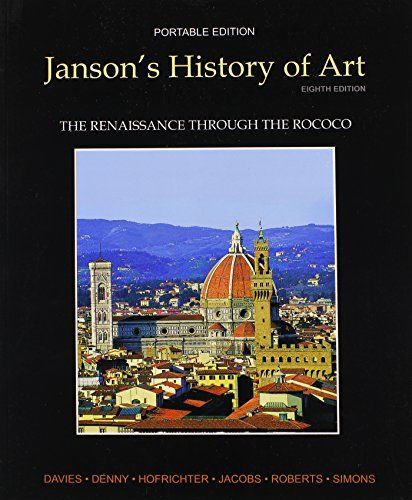
Janson's History of Art: The Renaissance through the Rococo
ALERT: Before you purchase, check with your instructor or review your course syllabus to ensure that you select the correct ISBN. Several versions of Pearson's MyLab & Mastering products exist for each title, including customized versions for individual schools, and registrations are not transferable. In addition, you may need a CourseID, provided by your instructor, to register for and use Pearson's MyLab & Mastering products. Packages Access codes for Pearson's MyLab & Mastering products may not be included when purchasing or renting from companies other than Pearson; check with the seller before completing your purchase. Used or rental books If you rent or purchase a used book with an access code, the access code may have been redeemed previously and you may have to purchase a new access code. Access codes Access codes that are purchased from sellers other than Pearson carry a higher risk of being either the wrong ISBN or a previously redeemed code. Check with the seller prior to purchase. -- For courses in the History of Art. Rewritten and reorganized, this new edition weaves together the most recent scholarship, the most current thinking in art history, and the most innovative online supplements, including MyArtsLab and the Prentice Hall Digital Art Library. Experience the new Janson and re-experience the history of art. The Portable Edition of Janson's History of Art, Eighth Edition features four lightweight, paperback books packaged together along with optional access to a powerful student website, www.myartslab.com , making the text more student friendly than ever. Janson's History of Art is still available in the original hardcover edition and in Volume I and Volume II splits. The Portable Edition is comprised of four books, each representing a major period of art history: Long established as the classic and seminal introduction to art of the Western world, the Eighth Edition of Janson's History of Art is groundbreaking. When Harry Abrams first published the History of Art in 1962, John F. Kennedy occupied the White House, and Andy Warhol was an emerging artist. Janson offered his readers a strong focus on Western art, an important consideration of technique and style, and a clear point of view. The History of Art, said Janson, was not just a stringing together of historically significant objects, but the writing of a story about their interconnections, a history of styles and of stylistic change. Janson's text focused on the visual and technical characteristics of the objects he discussed, often in extraordinarily eloquent language. Janson's History of Art helped to establish the canon of art history for many generations of scholars. The new Eighth Edition, although revised to remain current with new discoveries and scholarship, continues to follow Janson's lead in important ways: It is limited to the Western tradition, with a chapter on Islamic art and its relationship to Western art. It keeps the focus of the discussion on the object, its manufacture, and its visual character. It considers the contribution of the artist as an important part of the analysis. This edition maintains an organization along the lines established by Janson, with separate chapters on the Northern European Renaissance, the Italian Renaissance, the High Renaissance, and Baroque art, with stylistic divisions for key periods of the modern era. Also embedded in this edition is the narrative of how art has changed over time in the cultures that Europe has claimed as its patrimony.